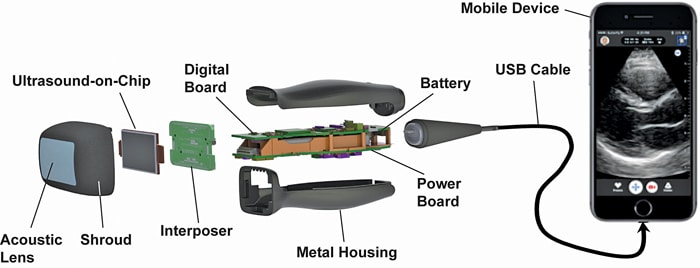About two-thirds of the world’s population lacks access to medical imaging, whether in developing nations or communities living in underdeveloped nations. Built on a chip, Butterfly Network has been providing solutions to the above said problem. This is through its
specifically designed 3D ultrasound imaging system on a chip (SoC).
Diagnostic ultrasound, also called sonography or diagnostic medical sonography, is an imaging method that uses sound waves to produce images of organs within your body. The images can provide valuable information for diagnosing and directing treatment for a variety of diseases and conditions.

Most ultrasound scannings are done outside the body but some are done by placing a small probe inside the body. Traditional ultrasound scanning devices used by radiologists work via piezoelectric crystals. Here an oscillating crystal produces sound waves that generate an image. At present, such scanning probes cost $8,000 while the traditional ultrasound unit itself costs $100,000 or more.
Nowadays there is much discussion about Butterfly Network and its iQ ultrasound probe. This probe is a nano, handy, and point-of-care ultrasound probe in a saturated ultrasound scanning market. The Butterfly Network has found a way to generate these sound waves with semiconductor chips.
There are massive efficiencies associated with the semiconductor fabrication process, which have already made the iQ probe the cheapest device on the market and cost just $1,999. More importantly, however, the semiconductor approach means the iQ probe will follow Moore’s Law and will become massively cheap and better with time. This semiconductor approach also gives the iQ probe a massive acoustic bandwidth, a critical detail that makes it uniquely portable.
The narrow bandwidth of traditional ultrasound means that a variety of probes are needed. For example, one probe for the deep structures of the abdomen and another for the superficial thyroid gland. You thus have to transport a large device and/or multiple probes around the hospital.
Jonathan Rothberg, an entrepreneur in the biomedical industry, is behind the development of the Butterfly iQ probe. This iQ probe is FDA-approved for 13 different applications with a single probe, which is the maximum ever for a single ultrasound device.
Just one high-bandwidth tool can scan the abdomen, the blood vessels, the thyroid gland, and various other systems, in addition to guiding medical procedures. Doing it all with a single probe is hugely beneficial for physicians and reduces scanning space. Although this portability might sound like mere convenience, its mass production in the future might replace the stethoscope.
| Lighting: 1.25 meters USB-C: 2 metrev | |
| Item | Probe Specification |
| Probe dimension | 85×56×35mm |
| Probe weight | 313 grams |
| Power | Battery (rechargeable) |
| Battery life | 2 hours for continuous scanning |
| Display | Variable |
| Min/Max scan depth | 1cm min / 30cm max |
| Ultrasound chip | Integrated CMOS chip |
| Transducer | 9000-element CMUT |
| Frequency range | 1-10MHz |
| Cable length | Lighting: 1.25 metres USB-C: 2 metrev |
A study showed that first-year medical students using ultrasound can diagnose cardiac abnormalities better than expert cardiologists using stethoscopes. There are many other use cases where ultrasound scanning is more powerful than the clinical exam, for example, from detecting an aneurysm to rapidly diagnosing fluid in the abdomen.
Similarly, using ultrasound to visualize a blood vessel when placing a catheter has shown significant benefits relative to doing it blindly, which is the present clinical standard in some cases. With time, this technology might allow the patients to do their own ultrasound scanning. Butterfly Network is making an early start in this regard.
| Table 2: Piezoelectric Crystal Based Ultrasound Scanning Vs Chip Based Ultrasound Scanning | |
| Piezoelectric Based Ultrasound Scanning | Piezoelectric-based crystal produces ultrasound |
| For each application, a separate probe is required | Chip produces ultrasound |
| Costs around $8,000 | Butterfly network probe iQ costs $1,999 (at release) |
| For each application a separate probe is required | All applications can be done with a single probe |
| Needs more storage space | Needs less storage space |
| Domestic scanning is not possible | Domestic scanning is possible |
| Image clarity is high | Image clarity is less |
| More reliable | Less reliable |
Butterfly iQ probe works with Apple and Android devices using the Butterfly iQ app. Butterfly iQ probe specifications are given in Table 1 above.
In conclusion, just like a domestic blood sugar tester, it can make home scanning possible. It can reduce scanning costs to a great extent and make medical imaging technology easy and available everywhere. It can revolutionize medical imaging in hospitals and clinics. It can change the game in global health and soon become a consumer product that will be as easily available as the household thermometer.
The author, Vinayak Ramachandra Adkoli, is BE in industrial production and has served as a lecturer in three different polytechnics for ten years. He is also a freelance writer and cartoonist






